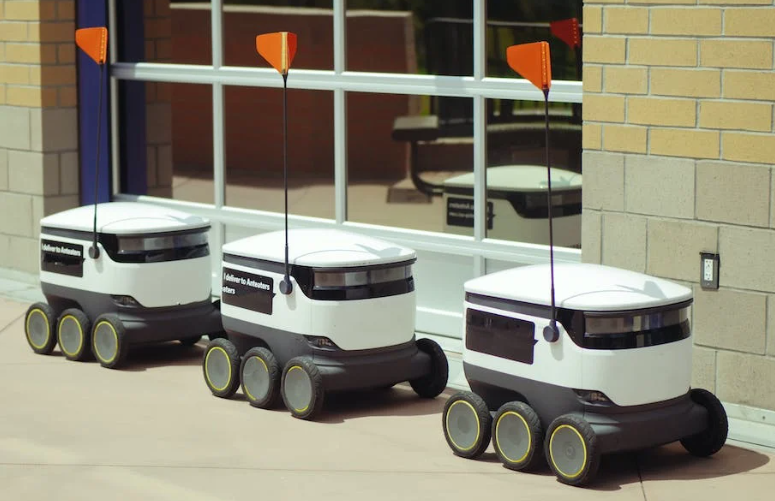In the realm of technological innovation, where Robot Science meets entrepreneurial spirit, a powerful synergy has emerged. Startups, those agile and audacious ventures, have joined forces with the ever-advancing field of Robot Science to catalyze a revolution. This dynamic partnership is reshaping industries, propelling growth, and challenging the boundaries of what we once deemed possible. As we delve into the world where startups and robotics converge, we embark on a journey through innovation, disruption, and the limitless potential of human ingenuity.
- The Robotics Revolution in Startups
The integration of robotics technology into startup operations has opened up a world of possibilities, reshaping the way startups across diverse industries operate and innovate. These groundbreaking developments leverage robotics to enhance efficiency, reduce costs, and deliver cutting-edge solutions.
Here are key areas where startups are making significant strides:
- Manufacturing and Automation: Startups are leveraging robotics to revolutionize manufacturing processes. This transformation encompasses various aspects, from 3D printing technologies that enable rapid prototyping and customization to automated assembly lines where robots work alongside human workers. The integration of robotics in manufacturing is streamlining production, reducing errors, and significantly increasing overall productivity. This not only accelerates the time to market but also enhances the quality and precision of manufactured products.
- Healthcare and Medical Robotics: In the healthcare sector, startups are pioneering the development of medical robots that have far-reaching implications for patient care and medical procedures. These robots are designed to assist surgeons in delicate operations, deliver medications with remarkable precision, and provide telemedicine solutions, extending healthcare access to remote or underserved areas. Such advancements are enhancing the efficacy of medical treatments, reducing the risk of human error, and ultimately improving patient outcomes.
- Agriculture and AgTech: Agriculture is undergoing a technological renaissance with robotics-driven startups at the forefront. These innovators are creating autonomous drones and robots tailored for various agricultural tasks, including planting, harvesting, and monitoring crop health. Equipped with advanced sensors and AI algorithms, these technologies optimize resource utilization, minimize environmental impact, and significantly increase crop yields. By automating labor-intensive agricultural processes, startups are contributing to the sustainability and efficiency of the agriculture sector.
- Logistics and Warehousing: Logistics and warehousing have witnessed a transformative shift powered by robotics-driven startups. Autonomous robots, equipped with advanced navigation systems and sensing technologies, are taking on tasks previously performed by human workers. These tasks include sorting, packing, transporting goods, and even fulfilling orders in highly dynamic warehouse environments. The result is a significant boost in the speed and efficiency of supply chain operations. This not only reduces operational costs but also enhances the overall reliability and accuracy of logistics processes, meeting the ever-increasing demands of modern e-commerce and distribution networks.
- Retail and Customer Service: In the world of retail, robotics startups are introducing innovative solutions to enhance customer experiences and streamline operations. These innovations range from customer service robots that assist shoppers with inquiries and navigation to automated inventory management systems that optimize stock levels and reduce the risk of stockouts. Robotics in retail environments not only enhances the overall shopping experience by providing real-time assistance but also delivers substantial cost savings by reducing labor expenses. These developments align with the evolving expectations of consumers in a digitally connected retail landscape.
This robotics revolution in startups represents a fundamental shift in how industries operate, emphasizing the adaptability, precision, and efficiency that robotics technology brings to the forefront. As these startups continue to innovate and push the boundaries of what’s possible, they are reshaping industries and driving progress in ways that were once considered science fiction.
- Startups Pioneering Robotics Innovation
Let’s take a closer look at a few startups that are at the forefront of robotics innovation:
- Boston Dynamics: Advancing Robotics Across Industries
Boston Dynamics has earned international acclaim for its advanced robotic creations, which have redefined the possibilities of robotics across a spectrum of industries. One of Boston Dynamics’ most renowned creations is Spot, a versatile and adaptable robotic platform.
Spot is equipped with advanced mobility, agility, and the ability to navigate challenging terrains. Its applications span a multitude of sectors, including construction, utilities, public safety, and more. In construction, Spot is used to inspect and survey sites, reducing the need for human workers to enter potentially hazardous areas. This enhances both safety and efficiency in construction operations.
In the utilities sector, Spot performs tasks such as remote inspection of power lines and facilities. This ensures the reliability of essential services while minimizing risks to human workers. In public safety scenarios, such as search and rescue missions and disaster response efforts, Spot’s mobility and adaptability make it a valuable asset in situations where human access may be limited or dangerous.
- Covariant: AI-Powered Robotics for Complex Environments
Covariant stands out as a leader in the field of artificial intelligence (AI) for robotic systems, focusing on making robots adaptable and intelligent in complex, unstructured environments. Covariant’s expertise in AI, particularly in machine learning and reinforcement learning, allows robots to learn and adapt from human demonstrations and interactions.
Their technology finds applications in a wide range of industries, including logistics, manufacturing, and e-commerce. In logistics, Covariant’s robots optimize operations such as warehouse automation, order fulfillment, and material handling, streamlining supply chains and enhancing productivity.
In manufacturing, Covariant’s robots improve quality control, precision, and overall productivity. Real-world instances highlight their impact in enhancing manufacturing capabilities and efficiency.
- Ava Robotics: Revolutionizing Remote Collaboration with Telepresence Robots
Ava Robotics specializes in the development of telepresence robots, designed to revolutionize remote collaboration by bringing individuals virtually together in different locations. These robots are equipped with cutting-edge features such as high-definition cameras, interactive displays, and advanced mobility.
Their applications are diverse, spanning corporate offices, educational institutions, healthcare facilities, and various workplace environments. In corporate settings, Ava’s robots enhance communication and collaboration among remote teams, offering a sense of physical presence and improving the quality of virtual meetings.
In healthcare, Ava’s telepresence robots are integrated into settings where medical professionals remotely consult with patients and collaborate with colleagues. This extends medical expertise to underserved areas, improving patient care and access to healthcare resources.
By providing this level of detail, the article paints a comprehensive picture of each startup’s contributions to robotics innovation. It highlights their specific technologies, industry applications, and the real-world impact they have in shaping the future of robotics across various sectors.
- Challenges and Opportunities in Robotics Startups
While the marriage of startups and robotics promises tremendous potential, it is not without its unique set of challenges and opportunities. Let’s take a closer look at what robotics startups are facing and the potential rewards they stand to gain:
Challenges:
- Regulatory Complexity: The regulatory landscape for robotics can be complex and varies by region. Navigating these regulations, particularly in sectors like healthcare and autonomous vehicles, can be a significant hurdle.
- High Development Costs: Robotics development often requires substantial investment in research, development, and prototyping. Securing funding and managing costs can be challenging for startups, particularly those in the early stages.
- Talent Shortages: Building and maintaining robotics systems demand specialized skills in fields such as mechanical engineering, software development, and artificial intelligence. The competition for talent can be intense, making it difficult for startups to attract and retain top talent.
- Interoperability and Integration: Integrating robotics into existing systems and processes can be complex. Startups need to ensure that their solutions seamlessly integrate with customers’ operations, which may involve addressing compatibility issues.
- Ethical Considerations: Robotics technologies raise ethical questions, especially in areas like AI and autonomous systems. Startups must grapple with issues related to ethics, transparency, and accountability as they develop and deploy their solutions.
Opportunities:
- Market Disruption: Robotics startups have the potential to disrupt established industries by offering innovative solutions that are faster, more efficient, and cost-effective. This disruption can lead to significant market opportunities.
- Cost Reduction: For many sectors, robotics can reduce operational costs over the long term. Startups that can offer cost-effective solutions have a competitive advantage.
- Technological Advancements: Robotics startups often pioneer cutting-edge technologies. These innovations can not only solve existing problems but also open up new possibilities, creating blue ocean markets.
- Global Reach: In the digital age, startups have greater access to a global customer base and can quickly expand their reach. This allows them to tap into international markets and diversify their customer portfolio.
- Partnerships and Collaborations: Collaborations with established companies, research institutions, and other startups can provide valuable resources, expertise, and market access.
Conclusion
The synergy between startups and robotics has ushered in a transformative era, redefining industries and fostering unparalleled growth. These dynamic ventures, driven by innovation and a relentless pursuit of excellence, are charting new territories and revolutionizing established norms. The impact of this collaboration is profound, as it introduces solutions that not only optimize efficiency but also curtail costs and elevate the standards of products and services.
As technology continues its relentless march forward, startups are poised to take on an increasingly influential role in the ongoing robotics revolution. Their agility, creativity, and adaptability position them as catalysts of disruption, reshaping traditional sectors and fueling expansive growth.
In essence, startups have emerged as the vanguard of innovation, harnessing the full potential of robotics technology to address complex challenges and seize untapped opportunities. They are pushing the boundaries of what was once considered impossible, bringing forth a future where robotics will be an integral part of our daily lives.
The journey of startups and robotics is not one of mere evolution but of revolution, where progress knows no bounds. As we look ahead, we can anticipate a landscape where these pioneering ventures continue to leave an indelible mark on industries, enriching our lives, and propelling us into a future where the possibilities are limited only by our imagination. The union of startups and robotics stands as a testament to human ingenuity and our relentless pursuit of innovation, a journey that promises to reshape the world as we know it.








Leave a Comment
You must be logged in to post a comment.